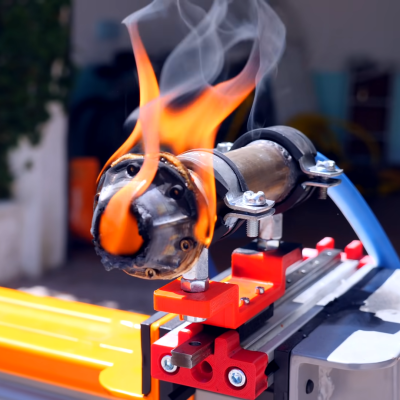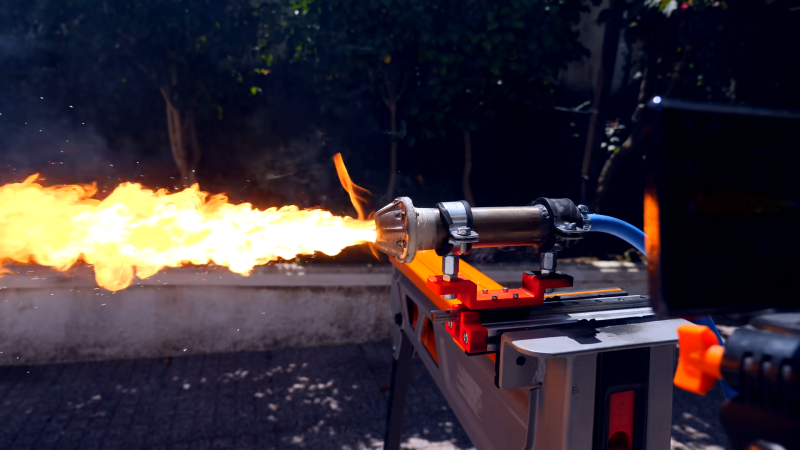Rocket engines are great for producing thrust from fire and fury, but they’re also difficult to make. They require high-strength materials that can withstand the high temperatures involved. [Integza], however, has tried for a long time to 3D print himself a working rocket engine. His latest attempt involves printing an aerospike design out of metal.

The project relies on special metal-impregnated 3D printer filaments. The part can be printed with a regular 3D printer and then fired to leave just the metal behind. The filament can be harsh, so [Integza] uses a ruby nozzle to handle the metal-impregnated material. Processing the material requires a medium-temperature “debinding” stage in a kiln which removes the plastic, before a high-temperature sintering process that bonds the remaining metal particles into a hopefully-contiguous whole. The process worked well for bronze, though was a little trickier for steel.
Armed with a steel aerospike rocket nozzle, [Integza] attempts using the parts with his 3D printed rocket fuel we’ve seen before. The configuration does generate some thrust, and lasts longer than most of [Integza]’s previous efforts, though still succumbs to the intense heat of the rocket exhaust.
Overall, though, it’s a great example of what it takes to print steel parts at home. You’ll need a quality 3D printer, ruby nozzles and a controllable kiln, but it can be done. If you manage to print something awesome, be sure to drop us a line. Video after the break.
















1st
Neat
Many tomatoes were injured in the making of this part.
Why isn’t [Integza] as rich as Elon Musk!? We’d be in the friggin’ Andromeda galaxy by now if he was!
Probably wasn’t born to rich parents.
Or rather he chooses to try things by himself. Like 3d-printing a nozzle and then just blasting some pure oxygen through it, which as we know, makes engine-rich exhaust. He is just goofing around. I don’t say it’s bad, it’s just reason why he is not like Elon. I’m also not like Elon.
Elon isn’t like any of us. He isn’t an engineer. Just is able to attract the right engineers to fulfil his visions. With money, vision, persuasion, and anything else he has on hand that other people want.
How do you define engineer?
You should see recent Everyday Astronaut interview with him, It’s over 2.5h tagging along on site, but it’s worth it.
> Just is able to attract the right engineers to fulfil his visions.
Not “JUST”, he can attract right engineers AND talk to them to get the best results, because he undarstands them and has engineering skills himself, so he knows what he’s doing.
Imagine an improved process making firearms at home.
There are some pretty interesting processes for that already, but I like how you think!
No way would I trust a 3D printed barrel for more than a single shot. The pressure is way too high. You can do single shots in plastic just fine already.
Why?
It might get you a Darwin Award.
The nozzle looks like it was designed by looking at a comic book. Good for entertainment purposes i guess but no metal would stand a chance with those.
Do you refer to something specific in the geometry? Because otherwise it’s an usually looking aerospike nozzle IMHO. And if you have seen them only in a comic book that’s very sad.
I would try real ceramics. I think he invented the oxy-plastic cutting torch. Steel doesn’t stand a chance.
I saw someone mention that they should be printing fuel rich. Either way it’s just so cool to be able to print metal at home at all. The future is really here.
Ahem, burning fuel rich. Otherwise the oxygen will combust the steel (actually a neat idea to do on purpose— I’ve heard of plans to send rockets to mars that arrive empty and then use the engines and tanks themselves as fuel.)
Sounds like a cool idea and fun to read about. Link?
Here’s one about magnesium and CO2:
https://arc.aiaa.org/doi/abs/10.2514/3.23609?journalCode=jpp
Filament used? Or just steel
https://shop.thevirtualfoundry.com/collections/metal-filaments
How do I know? Because I actually watched the video.
…to burn off that scarce oxygen painstakingly wrung out from the already thin CO2 carefully scroll-pumped out of the Martian atmosphere.
All that using up reams of solar energy harvested via eye-wateringly expensive solar cells sent from Mom’s basement (aka Earth), because the necessary manufacturing depth will take us ~150..~500 yrs to achieve.
Kind of makes sense, yes ;-P
I would guess there’s a whole lot of Silicon Dioxide on Mars. Only have to figure out how to split the Dioxide off the Silicon using some available energy source.
(BTW. I was replying to Wayne’s first post above, about burning steel in Mars to get energy. Comment system seems sometimes… potluck. Interesting ;-)
Adblockers break it – I’ve found you have to allow typekit, wordpress and wp through or replies go to the bottom.
Good of HaD to not fix it or make a little notice about it though…
I suspect he’d have better strength if he tuned his extrusion a bit. Particularly the bronze piece could benefit from increased extrusion to fill some holes.
I’m still working my way up to trying it so mine is not an informed opinion… yet.
But lost PLA casting makes way more sense to me than these metalized filaments that get fired.
All ways to get metal look like a lot of effort. If I’m going to make that effort I probably am after the full strength of a solid metal part. I know the part shrinks as it fires which takes up some of the space that the plastic once occupied but on a microscopic level are there really no voids left by the burnt off plastic? Is the part really as dense as something that was made of metal to begin with? Are the layers fully fused with no chance of delamination?
I agree. That furnace will reach the right temp for casting too.
Casting and sintering both have their pros and cons and are useful for different things.
Casting for instance is great for aluminum whereas when sintering there is a giant battle against oxidation. Meanwhile, copper is a pain to accurately cast but is one of the easiest items to sinter. Casting is great for a big bulk item where material cost is a bigger consideration but sintering may be way easier in terms of how much time you have to spend preparing each part when doing a bunch of small things.
There are also geometry considerations: when casting, everything has to be connected together, so you can’t make chainmail for instance, whereas when sintering this is easy. All in all, having some variety in techniques available is good in my opinion!
He’s still mounting the nozzles to a flange on the end of the fuel grain instead of putting a metal flange on the housing.